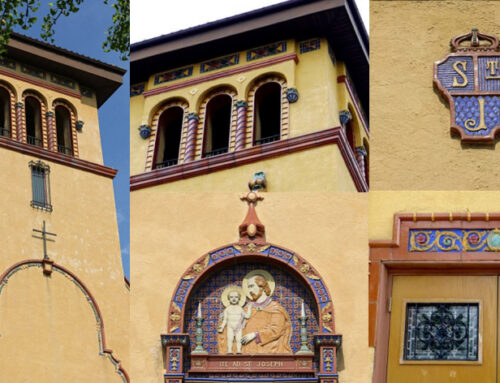Count Berthold von Imhoff (1868–1939) was a renowned artist celebrated for his religious murals and paintings. Born in Mannheim, Germany, he demonstrated artistic talent from a young age, studying at various European art institutions. In 1884, he received the Art Academy Award of Berlin for his painting “The Glory of Emperor Frederick.”
Below: Count Berthold von Imhoff.

In 1891, Imhoff married Matilda Johner and, seeking greater artistic freedom, emigrated to North America. The family settled in Reading, Pennsylvania, where Imhoff established a successful art and fresco business. During his time in Reading, approximately 1900 to 1913, he was a member of St. Paul’s Parish and painted numerous churches in the area, including more than 100 frescoes and murals in churches in eastern Pennsylvania, with at least 18 in Berks County.
In 1914, seeking a peaceful environment for his work, Imhoff relocated with his family to St. Walburg, Saskatchewan, Canada. From his studio there, he continued to produce religious artworks, often donating his services to small prairie churches. In 1926, Imhoff completed what is considered one of his masterpieces: the murals adorning the ceiling of St. Peter’s Roman Catholic Church in Reading, Pennsylvania. This extensive work features 224 life-sized depictions of saints, martyrs, virgins, and other significant Catholic figures. Many of these paintings were initiated in his Saskatchewan studio and later transported to Reading for completion by Imhoff and his family.
St. Peter’s parish ranks among the oldest in the United States. It is third, in point of time, in Pennsylvania; St. Joseph, in Willing’s Alley, having been established in 1734; the church at Goshenhoppen (now Bally), Berks County in 1741, and St. Peter’s in 1752.
St. Peter’s Church presented an unusual opportunity for mural decorations; the use of steel trusses and cantilever construction affording ample space for pictures. Modern engineering made possible the elimination of columns.
The ceiling is divided into sixteen rectangular panels, each approximating fourteen feet in width by twenty-three in height. Of these, two are in the sanctuary, twelve in the nave, and two in organ-gallery. All are so arranged that the pictures can be seen fully by day without artificial lighting.
Taking advantage of this exceptional opportunity, a plan was evolved which combines windows and mural decoration in one comprehensive scheme. Briefly stated, it is this: The windows of the nave depict scenes in the life, death and resurrection of our Savior.
The great East window reproduces Perugino’s fresco in the Sistine Chapel, “Christ Delivering the Keys to Peter.” It was donated by the Total Abstinence Beneficial Society of the church.
Below: East Window – Choir Loft.

Sanctuary
On the face of the sanctuary-arch is inscribed, “Thou art Peter, and upon this rock I will build My Church.” On either side of sanctuary-arch are adoring angels bearing candlesticks. The originals are in the tympanum of a side-portal in Rheims cathedral.
Below: Sanctuary – St. Peter’s R.C. Church, Reading, Pennsylvania.

The sanctuary panels are, respectively, St. Peter preaching to the peoples of the West, and St. Paul preaching to the peoples of the East. And, as a result of that preaching, we see marching up the nave a triumphant procession of Christ’s servants through the ages. They come forward proudly to the altar of the Most High bearing testimony that the mission of His Church has not been in vain. At the sanctuary-arch hangs the Rood, on which Christ is depicted in royal robes, crowned, and as the triumphant Redeemer. And, as a culminating feature, the sanctuary-windows represent Christ Enthroned in Glory receiving the adoration of the Church militant and the Church triumphant.
North Side of Church – St. Peter Preaching to the People of the West
The Prince of the Apostles, with the keys, insignia of his authority, in his left hand, is sounding the call to the new Faith. In the front rank of his hearers is a Roman family, the father with his son, the mother holding an infant. Behind these stand soldiers typifying the conquerors of the then known world. They are armed, and bear proudly aloft the standards of victory; but they have come to bow their haughty heads before the envoy of Christ. Then, a priest of the Capitoline Jupiter, who has brought with him the tripod-altar of sacrifice. There follow representatives of various tribes of the West who have been conquered by Rome. Many of these figures are reminiscent of the Column of Trajan.
Below: Sanctuary Mural – North Side of Church – St. Peter Preaching to the People of the West.

South Side of Church – St. Paul Preaching to the People of the East
Raising his arms in fervid appeal, the countenance of the Apostle is irradiated by the zeal with which he summons the diverse Oriental peoples to the worship of the true God. Kneeling at his feet are, Damaris who was converted with Dionysius the Areopagite; and Lydia, of Troas, who extended gracious hospitality to St. Paul and St. Luke. Behind these stand an Athenian mother and child. Then a high priest of the Jews in a noble gesture of prayer. An Egyptian high priest comes next. A Greek, in pallium of white wool, has at his feet the golden lyre of Apollo. Then follow some of the peoples specially named in the Acts of the Apostles, —Mede, Persian, Elamite, Armenian, Caucasian, Arab, and finally an Ethiopian with javelin, arrows and buckler. Though the Apostle is girt with the sword attributed to him by tradition, itis not the gospel of Force he preaches. Instead, he inculcates principles which, if carried out in practice, would bring about the kingdom of Christ on earth.
Below: Sanctuary Mural – South Side of Church – St. Paul Preaching to the People of the East.

Nave
North Side – Front to Back
Panel 1 – APOSTLES – St. Peter. St. Paul. St. Matthew. St. James the Less. St. John. St. Simon. St. Thomas. St. Bartholomew. St. Thaddeus. St. Andrew. St. James the Great. St. Philip.

Panel 2 – MARTYRS – St. Stephan. St. Lawrence. St. Denis. St. Polycarp, St. Pothinus, disciple of St. Polycarp. St. Cyr, Son of St. Juliana. St. Saturninus. In third century preached in Pryenees and Spain. St. Clement, Fourth Pope. St. George. St. Longinus. St. Maurice, St. Exuperius, St. Victor (Chiefs of Theban Legion). St. Sebastian. St. Christopher.

Panel 3 – DOCTORS OF THE CHURCH – St. Irenaeus. St. Cyril. St. Athanasius. St. Gregory of Nazianzus. St. Basil the Great. St. Jerome. St. Ambrose. St. Augustine. Bearing the effigy and book “City of God.” St. Hilary. St. John Chrysostom. St. Gregory the Great. St. Leo the Great. St. Thomas Aquinas. St. Bonaventure.

Panel 4 – BISHOPS – St. Nicholas, with the three children he miraculously saved. St. Martin of Tours. St. Medardus of Noyon. Sixth century. St. Remigius, Apostle of the Pranks. Bishop of Rheims. Receiving from Sacred Dove the ampula containing oil with which the kings of Prance were consecrated. St. Patrick. St. Ives of Chartres. St. Honoratus, patron of bakers. St. Eligius. Treasurer of Clovis. Bishop of Noyon in 640. Expert jeweler. St. Louis of Toulouse. St. Norbert. Founder of Premonstratensians. St. Charles Borromeo. St. Francis de Sales. Patron of Journalists.

Panel 5 – CONFESSORS – St. Joseph. St. Anthony. St. Benedict. Founder of western monasticism. St. Cloud or Clodoald. His two older brothers were murdered by his uncles. He escaped and founded a convent near Paris. St. Leonard. Godson of St. Remigius. Friend, and patron, of prisoners. St. Hubert, St. Fiacre. Renounced the throne of Scotland. Retired to Meaux. Patron of gardeners. St. Charlemagne. St. Gilles. An Athenian of royal rank. Came to Provence and founded a monastery in the Gard. St. Lazare of Byzantium. Patron of painters. St. Stephen of Hungary. St. Henry, Emperor of Germany.

Panel 6 – CONFESSORS – St. Marinus of Dalmatia. A stone-mason. Founded monastery which resulted in miniature Republic of San Marino. St. Bernard. St Bruno. St. Dominic. St Francis of Assis. St. Ferdinand of Castile. St. Louis. Bearing the Crown of Thorns which he brought from the Holy Land, and to receive which he built Sainte-Chappelle. St Peter Nolasco. Founder of Order of Mercy, for redemption of prisoners from the Moors. St. Anthony of Padua. St Vincent Ferrer. St. Roch. Fell a victim to the plague, whose ravages he sought to cure. Was driven into the forest, where his life was saved by a faithful dog who daily brought him bread. St Casimir. St Francis of Paul. St. Ignatius Loyola. St. Francis Regis. St. Francis Xavier.

South Side – Front to Back
Panel 1 – VIRGINS AND MARTYRS – St. Thecla, pupil of St. Paul. St. Appollina of Alexandria. St. Agnes. St. Barbara. St. Agatha. St. Catharine of Alexandria. St. Margaret. St. Cecilia. St. Lucy. St. Blandina. Martyred with St. Irenaeus in Lyons. St. Dorothy. St. Ursula and her Virgins.

Panel 2 – HOLY VIRGINS – St. Martha, sister of Lazarus. St. Genevieve, St. Scholastica, sister of St. Benedict. St. Pulcheria. Daughter of Arcadius, Emperor of Byzantium. St. Clara. Bearing the ciborium with which she repulsed the soldiers of Frederick II, in 1234. St. Catharine of Siena, St. Catharine of Bologna. Patron of painters. St. Aurea. Abbess of convent in Paris under St. Eligius, who introduced the Irish monastic rule. St. Theresa, St. Rose of Lima, St. Gertrude, St. Zita of Lucca. Patroness of domestic service.

Panel 3 – HOLY FAMILIES – St. John the Baptist. St. Elizabeth. St. Anne. St. Vitus and his nurse. St. Crescentia. Martyrs under Diocletian. St. Cyr, and his mother, St. Juliana. Martyrs Sts. Martial, Philip, Vitalis, Alexander, Silvanus, Felix and Januarius, and their mother. St. Felicitas. Martyrs under Emperor Antoninus. St. Helena. St Paula and her daughter. St Eustochium. Disciples and helpers of St. Jerome. St. Monica.

Panel 4 – HOLY FAMILIES – St. Clodoald, grandson of St. Clothilde, wife of Clovis St. Bathilde, wife of Clovis II. St. Adel aide, daughter of Rudolph, King of Burgundy, and wife of Lothaire. St. Margaret of Scotland, St. Elizabeth of Portugal, St. Elizabeth of Hungary, St. Catharine of Sweden, and mother. St. Bridget of Sweden, St. Frances, of Rome, with guardian angel. Founder of Oblate. St. Jean Francoise de Chantal St Jeanne de Valois. Daughter of Louis XI. Foundress of Order of Annunciation.

Panel 5 – HOLY PENITENTS – St. Mary Magdalen. St. Mary of Egypt. St. Pelagius. St. Thais. St. Mary the Penitent. St. Aglae. St. Afra. Suffered martyrdom by fire. St. Marina. St. Theodora. St. Margaret of Cortona.

Panel 6 – HOLY SPOUSES – St. Theopista, her children, and St. Eustachius, her husband. The latter a veteran of the wars of Vespasian and Titus. Martyr. St. Nathalie, wife of St. Adrian, chief of Legion in Gaul. St. Landric (founder of Hotel-Dieu, a copy of which is at his feet) St. Dentelin; St. Maubert and St. Adeltrude, children of St Vincent Madelgarius, Count of Hainaut and his wife, St. Valdetrude. St. Clodulf and St. Anseghisel, children of St. Arnulf, of Metz, grandfather of Pepin. St. Julian Hospitaler, of Antioch, St Basilissa, his wife. St Maria of Cabeza, wife of St. Isidor, of Madrid, the Laborer. Patron of peasants and workmen. St. Cunibert of Cologne. St. Delphine, wife of St Elzear, of Sabron.

Organ Gallery
Each of the two panels contains a reproduction of the musical angels from the Ghent altar-piece, painted about 1432.
North Side

South Side

Count Berthold von Imhoff’s dedication to religious art left an enduring legacy, with his masterpieces adorning churches across North America. The murals at St. Peter’s Church in Reading, Pennsylvania, showcases his artistic brilliance and deep spiritual devotion. Imhoff’s work continues to inspire and enrich communities, standing as a testament to his life’s mission of bringing faith and beauty together.
Imhoff’s contributions to religious art were recognized by Pope Pius XI, who awarded him a Knighthood in the Pontifical Order of St. Gregory the Great in 1937. He passed away in 1939 in St. Walburg, where his former home and studio have been preserved as a heritage site, attracting visitors interested in his life and work.






Leave A Comment